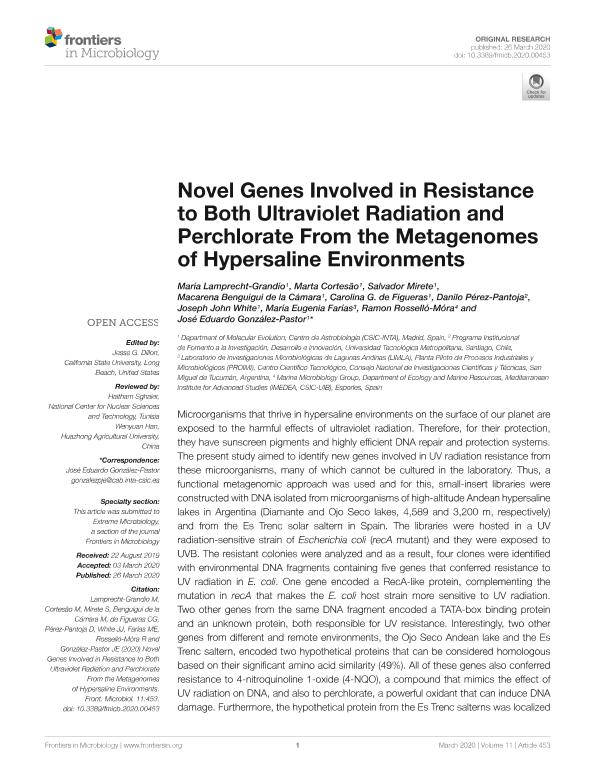Artículo
Novel Genes Involved in Resistance to Both Ultraviolet Radiation and Perchlorate From the Metagenomes of Hypersaline Environments
Lamprecht Grandío, María; Cortesão, Marta; Mirete, Salvador; Benguigui de la Cámara, Macarena; de Figueras, Carolina G.; Pérez Pantoja, Danilo; White, Joseph John; Farias, Maria Eugenia ; Rosselló Móra, Ramon; González Pastor, José Eduardo
; Rosselló Móra, Ramon; González Pastor, José Eduardo
 ; Rosselló Móra, Ramon; González Pastor, José Eduardo
; Rosselló Móra, Ramon; González Pastor, José Eduardo
Fecha de publicación:
03/2020
Editorial:
Frontiers Media S.A.
Revista:
Frontiers in Microbiology
e-ISSN:
1664-302X
Idioma:
Inglés
Tipo de recurso:
Artículo publicado
Clasificación temática:
Resumen
Microorganisms that thrive in hypersaline environments on the surface of our planet are exposed to the harmful effects of ultraviolet radiation. Therefore, for their protection, they have sunscreen pigments and highly efficient DNA repair and protection systems. The present study aimed to identify new genes involved in UV radiation resistance from these microorganisms, many of which cannot be cultured in the laboratory. Thus, a functional metagenomic approach was used and for this, small-insert libraries were constructed with DNA isolated from microorganisms of high-altitude Andean hypersaline lakes in Argentina (Diamante and Ojo Seco lakes, 4,589 and 3,200 m, respectively) and from the Es Trenc solar saltern in Spain. The libraries were hosted in a UV radiation-sensitive strain of Escherichia coli (recA mutant) and they were exposed to UVB. The resistant colonies were analyzed and as a result, four clones were identified with environmental DNA fragments containing five genes that conferred resistance to UV radiation in E. coli. One gene encoded a RecA-like protein, complementing the mutation in recA that makes the E. coli host strain more sensitive to UV radiation. Two other genes from the same DNA fragment encoded a TATA-box binding protein and an unknown protein, both responsible for UV resistance. Interestingly, two other genes from different and remote environments, the Ojo Seco Andean lake and the Es Trenc saltern, encoded two hypothetical proteins that can be considered homologous based on their significant amino acid similarity (49%). All of these genes also conferred resistance to 4-nitroquinoline 1-oxide (4-NQO), a compound that mimics the effect of UV radiation on DNA, and also to perchlorate, a powerful oxidant that can induce DNA damage. Furthermore, the hypothetical protein from the Es Trenc salterns was localized as discrete foci possibly associated with damaged sites in the DNA in cells treated with 4-NQO, so it could be involved in the repair of damaged DNA. In summary, novel genes involved in resistance to UV radiation, 4-NQO and perchlorate have been identified in this work and two of them encoding hypothetical proteins that could be involved in DNA damage repair activities not previously described.
Palabras clave:
UV
,
EXTREMOPHILES
,
ANDEAN LAKES
Archivos asociados
Licencia
Identificadores
Colecciones
Articulos(PROIMI)
Articulos de PLANTA PILOTO DE PROC.IND.MICROBIOLOGICOS (I)
Articulos de PLANTA PILOTO DE PROC.IND.MICROBIOLOGICOS (I)
Citación
Lamprecht Grandío, María; Cortesão, Marta; Mirete, Salvador; Benguigui de la Cámara, Macarena; de Figueras, Carolina G.; et al.; Novel Genes Involved in Resistance to Both Ultraviolet Radiation and Perchlorate From the Metagenomes of Hypersaline Environments; Frontiers Media S.A.; Frontiers in Microbiology; 11; 3-2020
Compartir
Altmétricas



